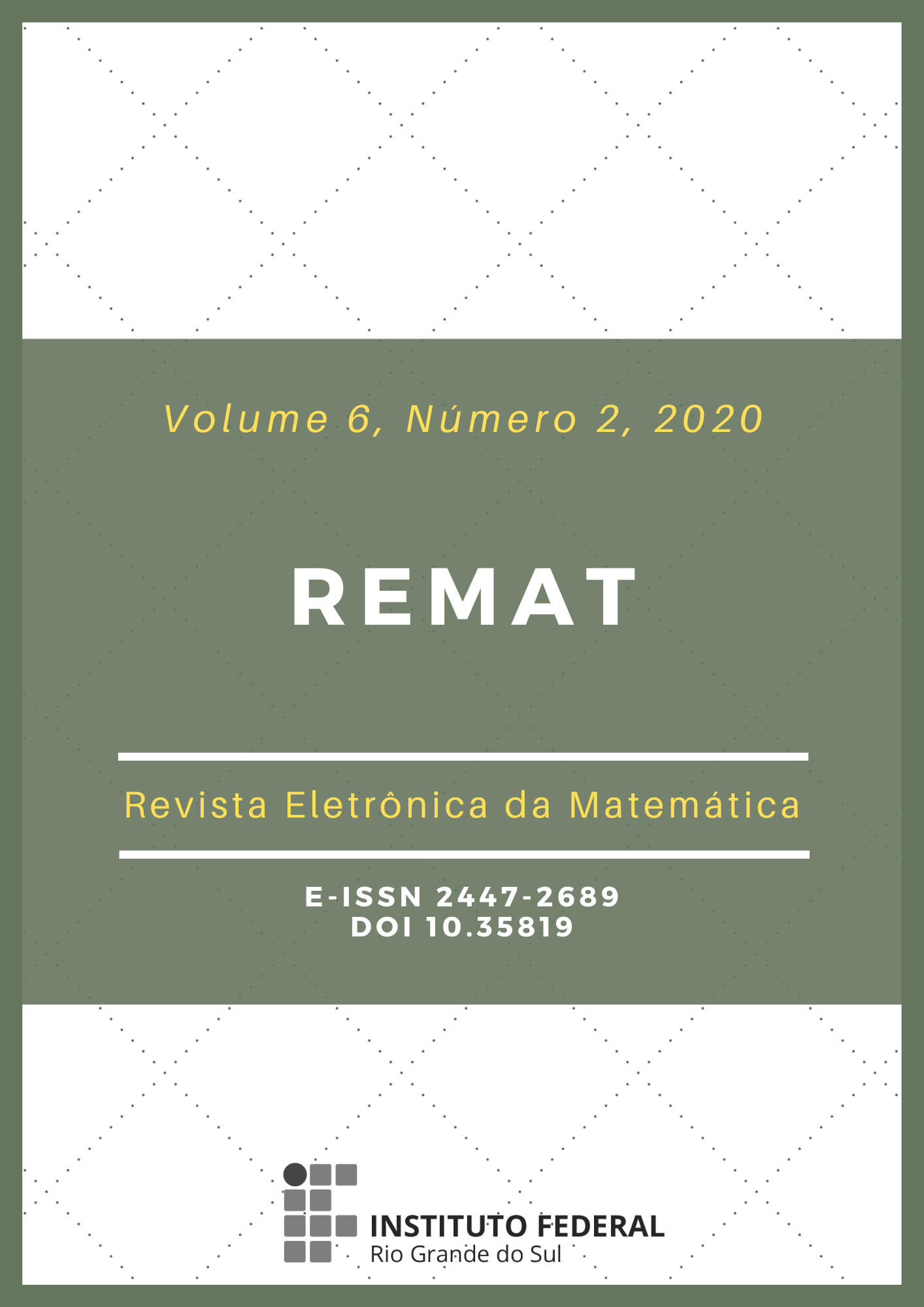Didactic experimentation aiming at teaching Analytical Geometry using smartphones: an adaptation of the School Reinforcement Project with GeoGebra app
DOI:
https://doi.org/10.35819/remat2020v6i2id4177Keywords:
Analytical Geometry, Smartphone, School Reinforcement, GeoGebra App, Mathematical EducationAbstract
This research proposes to present a didactic sequence based on an adaptation of the dynamics of the School Reinforcement Project of the State Education Secretariat of the State of Rio de Janeiro in partnership with the Foundation Center for Sciences and Distance Higher Education of State of Rio de Janeiro, using the smartphone as an integrated tool in the performance of students when carrying out the proposed activities. In order to create a more concrete, dynamic and interactive learning, the GeoGebra App was used. This is quantitative and qualitative research and the data collected sought to investigate the performance and reactions of students amidst the initial concepts of Analytical Geometry. It was possible to verify through the experiment, that the proposed didactic sequence, with the integrated use of the smartphone, with School Reinforcement Project dynamics adaptations aided by the GeoGebra App, contributed significantly to the learning of the proposed theme, encouraging the knowledge in a more attractive, dynamic and interactive way.
Downloads
References
ALMEIDA, M. E. B. de. Tecnologia na escola: criação de redes de conhecimentos. 18 jul. 2008. Disponível em : http://penta3.ufrgs.br/MEC-CicloAvan/integracao_midias/modulos/1_introdutorio/pdf/texto_Tecnologia_escola.pdf. Acesso em: 14 ago. 2020.
BASTOS, D. de O. Estudo da circunferência no Ensino Médio: sugestões de atividades com a utilização do software GeoGebra. 2014, 199 f. Dissertação (Mestrado Profissional em Matemática em Rede Nacional) – Universidade Federal do Rio Grande, Rio Grande, 2014.
BRASIL. Ministério da Educação. Secretaria de Educação Média e Tecnológica. Parâmetros Curriculares Nacionais: Ciências da Natureza, Matemática e suas Tecnologias. Brasília: MEC, SEMTEC, 2002.
CECIERJ, F. Projeto Reforço Escolar: manual. 2012. Disponível em: http://projetoseeduc.cecierj.edu.br/reforco-escolar.php. Acesso em: 14 ago. 2020.
COSTA, I. Novas tecnologias e aprendizagem. 2. ed. Rio de Janeiro: Wak, 2014.
CUNHA, H.; OLIVEIRA, H.; PONTE, J. P. da. Investigações matemáticas na sala de aula. Actas do ProfMat. Lisboa: APM, p.161-167, 1995.
D’AMBRÓSIO, U. Educação Matemática: da teoria à prática. 16. ed. Campinas: Papirus, 2007.
DRUCK, S. Matemática não é problema. Boletim 06, Campina Grande, p. 3-8, mai. 2005. Disponível em: http://pibidmatematicaces.files.wordpress.com/2013/10/livro-de-matemc3a1tica.pdf. Acesso em: 14 ago. 2020.
FONSECA, J. J. S. Metodologia da pesquisa científica. Fortaleza: Universidade Estadual do Ceará, 2002. Disponível em: http://www.ia.ufrrj.br/ppgea/conteudo/conteudo-2012-1/1SF/Sandra/apostilaMetodologia.pdf. Acesso em: 14 ago. 2020.
FREIRE, P. Pedagogia da autonomia: saberes necessários à prática educativa. 53. ed. Rio de Janeiro: Paz e Terra, 2016.
GUEDES, P. C. C. Aplicação do software GeoGebra ao ensino da Geometria Analítica. Revista Ciência e Natura, Santa Maria, v. 37, edição especial PROFMAT, p. 365-375, 2015. DOI: http://dx.doi.org/10.5902/2179460X14555.
MORAN, J. M.; MASETTO, M. T.; BEHRENS, M. A. Novas tecnologias e mediação pedagógica. 10. ed. Campinas: Papirus, 2000.
REGO, T. C. Vygotsky: uma perspectiva histórico-cultural da educação. Petrópolis: Vozes, 2013.
SANT’ANA, E. da C. Estratégia Didática para o Ensino de Geometria Analítica com o auxílio do Aplicativo GeoGebra. 2019. 161 f. Dissertação (Mestrado em Matemática) – Programa de Pós-Graduação Profissional em Matemática, Universidade Estadual do Norte Fluminense Darcy Ribeiro, Campos dos Goytacazes, RJ, 2019.
TENÓRIO, A.; SOUZA, S. M. R. de; TENÓRIO, T. O uso do software GeoGebra no estudo de Geometria Analítica. Revista do Instituto GeoGebra de São Paulo, São Paulo, v. 4, n. 2, p. 103-121, 2015. Disponível em: http://revistas.pucsp.br/IGISP/article/view/24003. Acesso em: 14 ago. 2020.
TOLEDO, F. S. Texto e contexto da educação a distância. 2003. Disponível em: http://www.lo.unisal.br/nova/aed/artigo1.html. Acesso em: 30 dez. 2017.
VALENTE, J. A. O Professor no Ambiente Logo: Formação e Atuação. 1. ed. Campinas: Gráfica da UNICAMP, 1996.
VALENTE, J. A. Mudanças na sociedade, mudanças na educação: o fazer e o compreender. In: VALENTE, José Armando (Org.). O computador na sociedade do conhecimento. Campinas: NIED-UNICAMP, 1999.
ZABALA, A. A prática educativa: como ensinar. 1. ed. Porto Alegre: Artmed, 2015.
Downloads
Published
Issue
Section
License
Copyright (c) 2020 REMAT: Revista Eletrônica da Matemática

This work is licensed under a Creative Commons Attribution 4.0 International License.
REMAT retains the copyright of published articles, having the right to first publication of the work, mention of first publication in the journal in other published media and distribution of parts or of the work as a whole in order to promote the magazine.
This is an open access journal, which means that all content is available free of charge, at no cost to the user or his institution. Users are permitted to read, download, copy, distribute, print, search or link the full texts of the articles, or use them for any other legal purpose, without requesting prior permission from the magazine or the author. This statement is in accordance with the BOAI definition of open access.













 https://orcid.org/0000-0002-0893-7426
https://orcid.org/0000-0002-0893-7426


















